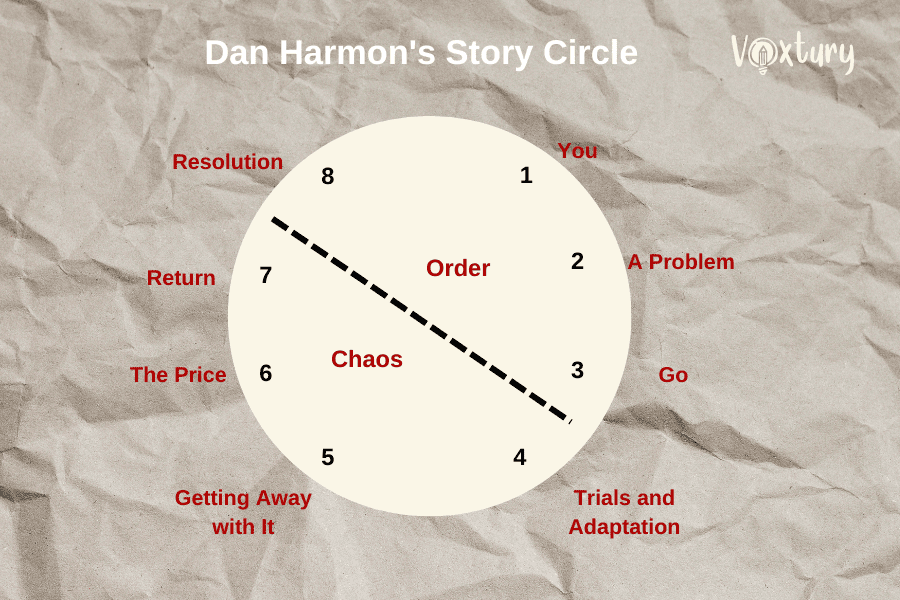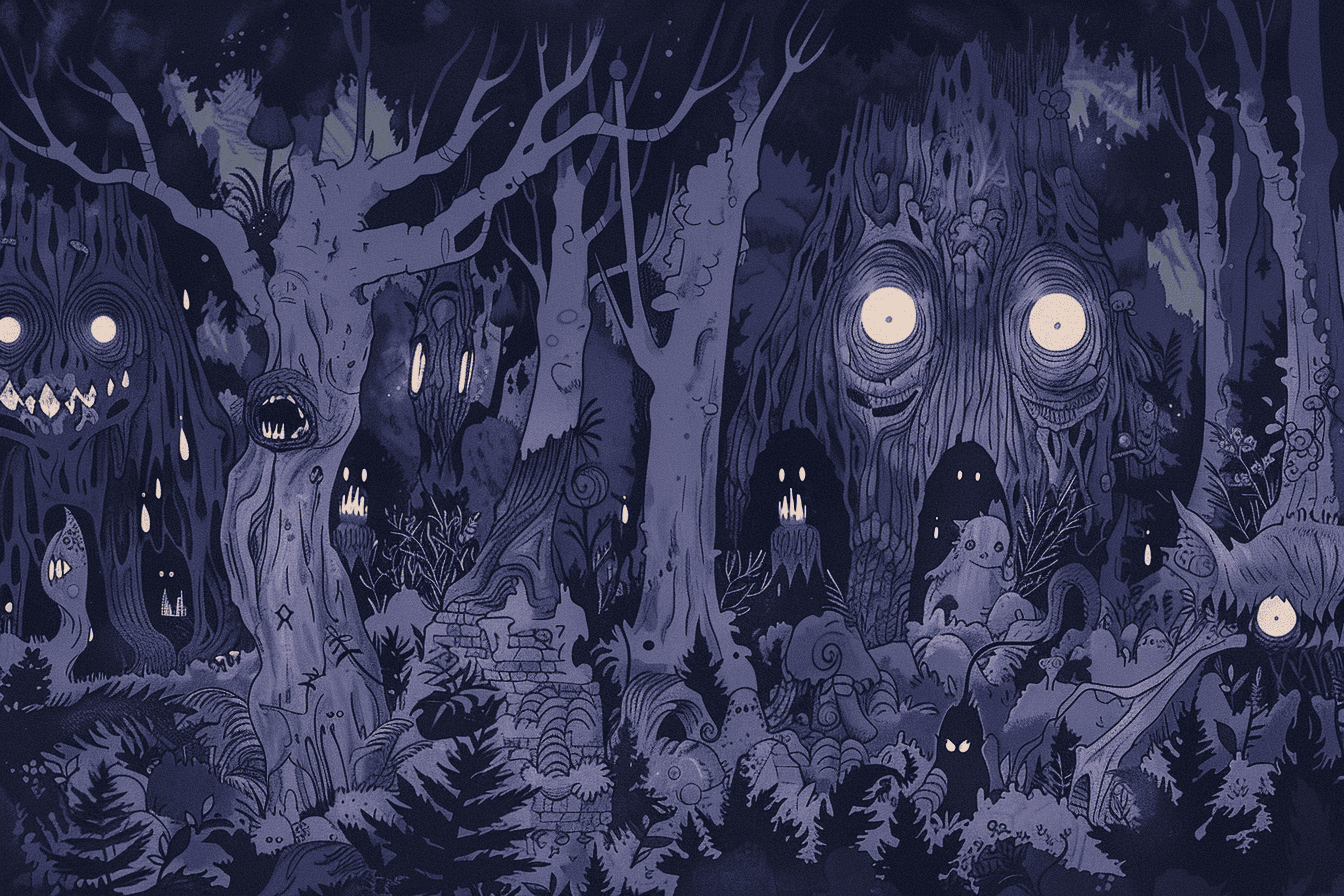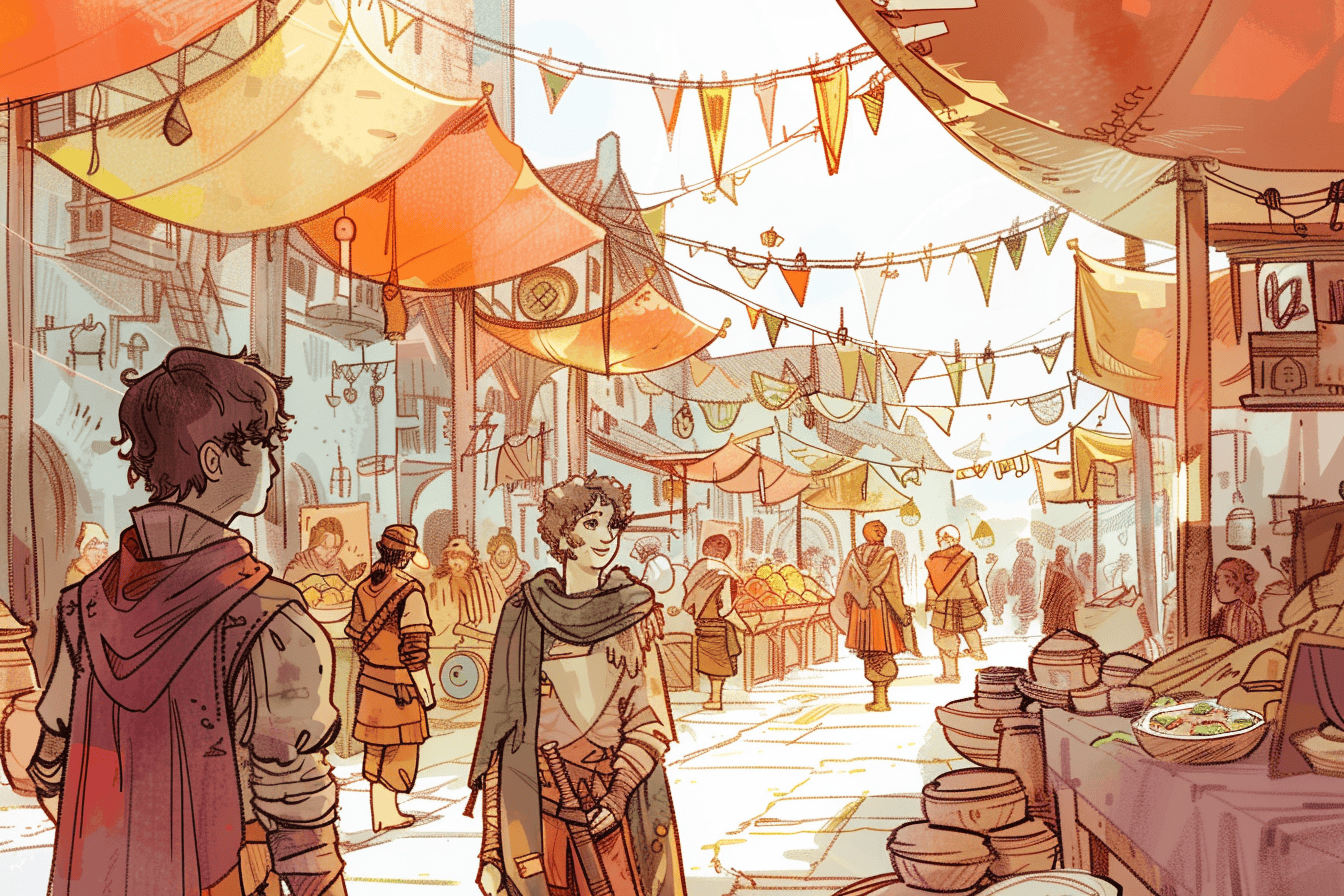Ever wondered why some stories captivate us while others fall flat? The secret might lie in a simple yet powerful storytelling framework: Dan Harmon’s Story Circle.
This eight-step structure has been used by countless writers to create compelling narratives across various mediums. And now, you can be the next to discover its whole potential.
In this useful guide, we will learn:
- What is the Dan Harmon Story Circle?
- How to use it + with great examples to illustrate it.
- What mistakes to avoid.
- And when this structure shines the brightest.
What Is the Dan Harmon Story Circle?
The Dan Harmon Story Circle is a simplified and streamlined version of the Hero’s Journey, a narrative structure popularized by Joseph Campbell.
It’s a cyclical framework that breaks down the storytelling process into eight distinct steps, making it easier for writers to construct compelling narratives.
Here are the eight steps of the Story Circle:
- You: The protagonist is in their comfort zone, leading a normal life.
- Need: Something disrupts this comfort, creating a desire or goal.
- Go: The protagonist leaves their familiar world and enters an unfamiliar situation.
- Search: They adapt to this new environment and learn new skills.
- Find: They achieve their goal or desire.
- Take: They pay a price for their success, facing a significant challenge or loss.
- Return: The protagonist returns to their familiar world, transformed by their experiences.
- Change: They apply their newfound knowledge and skills to their original world, leading to personal growth.

Dan Harmon, the creator of the hit TV shows Community and Rick and Morty is the mastermind behind the Story Circle. He adapted the Hero’s Journey to create a more accessible and practical framework for modern storytelling.
The Story Circle has become a popular tool for writers across various mediums, from screenwriting to novel writing.
Its simplicity and effectiveness have made it a valuable resource for anyone looking to craft engaging and meaningful stories.
Tell the Story You’ve Always Wanted To
Head on to our comprehensive Types of Story Structure – Exploring 7 Popular Plot Structures guide to learn all about different narrative blueprints and how you can use them to your full advantage!
Breaking Down the 8 Stages of Dan Harmon’s Story Circle
Ready to take a closer look at each stage of Dan Harmon’s Story Circle? Let’s analyze them using, as an example The Wizard of Oz.
1. You (Comfort Zone)
In this initial stage, the protagonist is introduced when living their everyday life, showcasing their comfort zone. This sets the baseline for their character.
- Clearly define the protagonist’s normal life to establish relatability.
- Use specific details to paint a vivid picture of their environment.
In The Wizard of Oz, Dorothy lives a mundane life on a Kansas farm, longing for adventure.
2. Need (a Problem)
The protagonist recognizes a desire or need that compels them to act. This need drives the narrative forward.
- Articulate what the protagonist wants and why it matters.
- Highlight emotional stakes to increase audience investment.
Dorothy wants to escape her dull life and find happiness, which motivates her journey.
3. Go (Crossing the Threshold)
Here, the protagonist steps into an unfamiliar world or situation, marking the transition from comfort to adventure.
- Create a clear moment of departure from the comfort zone.
- Introduce new challenges or opportunities that await in this new world.
Dorothy is swept away by a tornado to the magical land of Oz, leaving her familiar surroundings behind.
4. Search (Trials and Adaptation)
The protagonist faces trials in this new environment and must adapt to survive. This stage often involves learning new skills or gaining allies.
- Showcase character growth through challenges faced.
- Use setbacks to build tension and develop relationships with supporting characters.
Dorothy meets the Scarecrow, Tin Man, and Cowardly Lion as they navigate the dangers of Oz together.
5. Find (Achievement)
At this stage, the protagonist achieves their goal or finds what they were seeking, but it often comes with complications.
- Ensure that this achievement feels earned through previous struggles.
- Introduce elements that complicate this success, foreshadowing future challenges.
Dorothy reaches the Wizard of Oz but learns he is not who he seems, complicating her desire to return home.
6. Take (Paying the Price)
The protagonist must confront significant consequences for their actions or decisions made during their journey. This stage often involves sacrifice.
- Highlight the costs associated with achieving goals to deepen emotional impact.
- Use this moment to challenge the protagonist’s values or beliefs.
Dorothy must give up her silver shoes (or ruby slippers in the film) to defeat the Wicked Witch, illustrating her sacrifice for her friends’ safety.
7. Return (Journey Back)
In this phase, the protagonist returns to their familiar world but is changed by their experiences. This return often includes reflection on what has been learned.
- Create a sense of closure by showing how the protagonist’s journey has affected them.
- Reinforce themes established in earlier stages during this return.
After defeating the Wicked Witch, Dorothy returns home to Kansas, reflecting on her adventure and newfound wisdom.
8. Change (Transformation)
Finally, the protagonist has fundamentally changed due to their journey. They return not just physically but also emotionally transformed, often sharing their newfound wisdom with others.
- Clearly illustrate how the character has evolved throughout the story.
- Show how these changes affect their relationships and future decisions.
Dorothy learns that “there’s no place like home,” embracing her life in Kansas with a renewed perspective after her adventures in Oz.
The Benefits of Dan Harmon’s Story Circle
Okay, we’ve covered the basics of the Story Circle. But we still haven’t explained the benefits it brings. Let’s go through the key advantages of using Dan Harmon’s Story Circle in your work:
Clarity without Complexity
The eight-step structure of the Story Circle provides a clear and concise roadmap for storytelling. It breaks down the narrative journey into manageable stages, making it easier to visualize and plan the story’s progression.
Each step is essential, but the simplicity of the framework prevents it from becoming overwhelming, allowing writers to focus on the core elements of their story.
Adaptability to Different Genres, Formats, and Story Lengths
One of the most significant strengths of the Story Circle is its versatility. It can be applied to a wide range of genres, from comedy to drama, science fiction to fantasy. Whether you’re writing a short story, a feature film, or a television series, the Story Circle can be adapted to fit the desired length and format.
Its flexibility allows creators to tailor the structure to their specific needs, ensuring that the story remains engaging and impactful regardless of its medium.
Emphasis on Character Growth and Transformation
Finally, the Story Circle places a strong emphasis on character development and transformation. It encourages writers to focus on the internal journey of the protagonist, exploring their motivations, desires, and fears.
Each step in the circle represents a significant moment in the character’s arc, pushing them to confront challenges, make difficult choices, and ultimately emerge as a changed person. This focus on character growth ensures that the story resonates with audiences on an emotional level, creating a lasting impact.

How to Use the Dan Harmon Story Circle
Here are a few useful tips to wield the Dan Harmon Story Circle with ease.
#1 Build Clear Stakes and Challenges
There’s nothing quite as disappointing as a story without any real stakes. That’s why the golden rule with this and any other story structure is to make the stakes high enough to create tension and keep the audience on the edge of their seats.
The challenges your protagonist faces should be significant enough to test their limits and force them to grow. So start there. Think about all that growing your character needs to make and what hurdles on their way would best facilitate that.

#2 Pay Attention to 3 PM, 6 PM, and 9 PM
That’s a really practical and easy-to-implement tip. With this circular structure, you can view it as a clock in which the most important parts of your story take place around 3 PM, 6 PM, and 9 PM.
Now, our graph is not made to resemble a clock, so you will need to use your imagination here, but the stages around crossing the threshold, paying the price, and returning change are the most crucial elements of your story.
You can even start by plotting and writing those crucial moments in a story and work your way to the rest.
#3 Experiment with the Framework
Lastly, we’d like to encourage you to break the rules. Don’t be afraid to deviate from the traditional structure. The Story Circle is a guide, not a rigid formula. So, tailor the framework to fit the specific needs of your story. If you discover something new by chance, that’s only going to add to your story.
Need a Tool to Help You Excel?
Whether you’re crafting a story structure, rough draft, or book proposal, you need a tool that will help you bring out the unique magic in your words. That’s where Voxtury’s Online Rich Text Editor comes in.
Try this online editor to refine your story. With great formatting capabilities and a useful duplicate word finder, you can ensure your page represents the highest level of craft!
Common Mistakes to Avoid
Here are some common mistakes writers make when using the Story Circle and how to avoid them:
- Skipping the Need Stage:
- Why it’s a mistake: The Need/Problem stage establishes the protagonist’s desire and sets the story in motion. Skipping it can lead to a weak or unmotivated protagonist.
- How to avoid it: Clearly define what your protagonist wants and why they want it. Make sure the need is strong enough to drive the story forward.
- Underdeveloping Challenges:
- Why it’s a mistake: Challenges push the protagonist to grow and change. Underdeveloped challenges can lead to a predictable and boring story.
- How to avoid it: Make sure the challenges are significant and difficult to overcome. The higher the stakes, the more compelling the story.
- Making the Transformation Unclear:
- Why it’s a mistake: The transformation is the heart of the Story Circle. If it’s unclear, the audience won’t be able to appreciate the protagonist’s journey.
- How to avoid it: Clearly show how the protagonist has changed as a result of their experiences. This can be done through their actions, dialogue, or internal monologue.
- Rushing Through the Steps:
- Why it’s a mistake: Each step of the Story Circle is important. Rushing through any of them can lead to a weak or incomplete story.
- How to avoid it: Take your time and develop each step fully. Don’t be afraid to add additional scenes or subplots to flesh out the story.
- Forgetting the Antagonist:
- Why it’s a mistake: A strong antagonist can make a story more exciting and engaging.
- How to avoid it: Give your antagonist clear motivations and goals. Make them a worthy adversary for your protagonist.

When to Use the Dan Harmon Story Circle
Here’s a good question to ask yourself – do you even need the Dan Harmon Story Circle?
A structure like this is a fantastic tool for crafting short, repeatable formats like TV episodes, comics, or short stories for several reasons:
- Concise Structure: Its eight-step structure is concise and easy to remember, making it perfect for quickly planning and executing shorter stories.
- Character-Focused: The Story Circle emphasizes character growth and transformation. This makes it ideal for episodic storytelling, where characters can evolve over time.
- Clear Beginning and End: The structure provides a clear beginning and end, making it easy to identify the story’s core conflict and resolution.
- Predictability and Surprise: The Story Circle offers a balance of predictability and surprise. While the overall structure is familiar, specific plot points can be unexpected, keeping the audience engaged.
But, it can be adapted to longer formats like books. So, as long as your story revolves around transformation and the journey a character needs to go through to achieve it, you can utilize this tool with great success.
Wrapping Up
And with that, we reached the end of our journey. Returning home never felt so sweet!
But if you’re not ready to say goodbye just yet, head on to Voxtury’s book-writing resources. Learn about how to craft masterful dialogues, what exactly is an epilogue and how to write it, and how to use various points of view to tell an effective story.
Meanwhile, we wish you all the best, and see you next time!